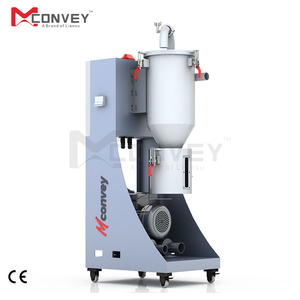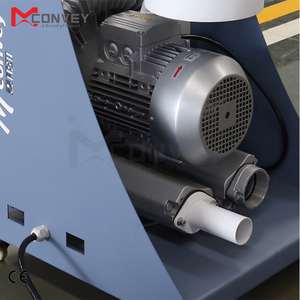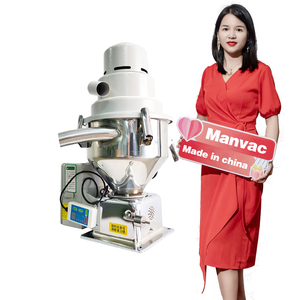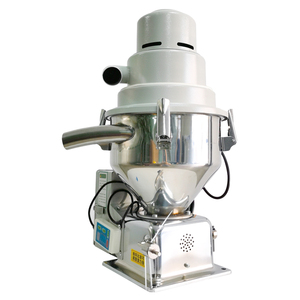
All categories
Featured selections
Trade Assurance
Buyer Central
Help Center
Get the app
Become a supplier

(6896 products available)





















































The automatic material loader is an essential component in the manufacturing of plastic products. It is used to transport raw materials from a storage container or bin to the processing machine. This machine is available in different types, each of which caters to the specific needs of various industries.
Vacuum loaders use negative pressure to transport materials from a storage bin to the processing machine's hopper. They use a vacuum generator to create suction, which conveys materials through hoses or pipes. The vacuum generator can be integrated into the loader or located remotely, depending on the model.
Central loaders are designed to handle large volumes of raw materials in centralized production facilities. They use a network of pipes or tubing to convey materials from multiple storage bins to several processing machines. It allows manufacturers to automate the process of loading materials and increase production efficiency.
Microladers are specially designed for use in situations where precise control is needed, such as in the medical or electronics industries. They are capable of handling very small quantities of materials with high accuracy. Micro-loaders can be used either as standalone units, or they can be integrated into existing production lines.
Self-contained loaders have their own control systems and material storage bins. Therefore, they can operate independently of any other equipment. They are typically used in smaller-scale production facilities or in situations where materials need to be loaded manually.
Gravimetric loaders are equipped with load cells that allow them to measure the weight of the materials being loaded. This enables precise control of the loading process and accurate record of the material usage. Gravimetric loaders are often used in industries where strict quality control and precise material management are required.
Dehumidifying loaders are equipped with drying units that remove moisture from the materials during the loading process. This is particularly crucial when dealing with hygroscopic materials or in environments with high humidity. Dehumidifying loaders help to maintain the quality and integrity of the materials and the final products.
The specifications of an automatic material loader can vary depending on the type, model, and manufacturer. Some key specifications include:
Proper maintenance is essential to the performance and longevity of an automatic material loader. Some key maintenance practices include:
Automatic material loaders are used in various industries to transport materials from one location to another. The following are some industry applications of the auto loaders.
Automatic plastic material loaders are widely used in the plastic industry to transport plastic pellets, powders, or compounds. These devices can be used to transport raw plastic materials from storage containers to processing machines such as extruders, injection molders, or blow molders.
In the food industry, automatic material loaders can be used to transport food ingredients, powders, or liquids in food production facilities. These devices can be used to transport ingredients from storage silos or containers to mixing equipment or food processing machines.
In the chemical industry, automatic material loaders are used to handle chemical materials, such as powders, granules, or liquids. They can be used to transport raw chemical materials from storage containers to mixing or processing equipment.
Automatic material loaders are used in the construction industry to transport building materials such as concrete, cement, aggregates, or sand. These devices can be used to transport raw materials from storage bins or silos to mixing equipment or construction machinery.
In the pharmaceutical industry, automatic material loaders are used to transport pharmaceutical ingredients, powders, or granules. These devices can be used to transport materials from storage containers to blending, granulation, or tablet pressing machines.
Automatic material loaders can be used in the metalworking industry to transport metal components, such as sheets, bars, or coils. These devices can be used to transport raw metal materials from storage racks to cutting, machining, or forming machines.
Automatic material loaders are used in the agricultural industry to transport agricultural products, such as grains, seeds, or fertilizers. These devices can be used to transport materials from storage silos to packaging or processing equipment.
Automatic material loaders are used in the automotive industry to transport automotive components, such as parts, assemblies, or subassemblies. These devices can be used to transport materials from storage areas to assembly lines or manufacturing cells.
When selecting an automatic material loader, it is important to compare the different features to ensure they are appropriate for the workplace's distinct needs.
This is the first important thing to consider when choosing an automatic material loader. The capacity will determine how much material can be transported at one time, which can affect the overall efficiency of the production process.
Choose an automatic material loader that is suitable for the factory's distinct working environment and material handling requirements.
The control system of the automatic material loader should be easy to operate and provide necessary safety features to ensure the safety of employees and materials.
Check the energy consumption of the material loader to ensure that it is in line with the company's environmental protection and energy-saving requirements. Choose a device that can operate efficiently and minimize energy consumption.
Consider the long-term maintenance and support requirements of the automatic material loader. Choose a reliable manufacturer that can provide timely technical support and maintenance services to ensure the normal operation of the equipment.
Consider the budget and choose an automatic material loader that provides the best performance and meets the requirements within the specified budget.
Q1 What is the difference between a hopper loader and an auto loader?
The hopper loader is a small loader, and usually, it is manual to load the material, while the auto loader is a machine that automatically loads the material into the machine.
Q2 What is the difference between a vacuum loader and an auto loader?
The vacuum loader is a machine that loads the material by vacuum pressure into the machine. The auto loader is a machine that loads the material automatically into the machine.
Q3 What are the different types of auto material loaders?
There are three major types of automatic material loaders, including the central control automatic feeding machine, the automatic suction machine, and the automatic weighing and mixing machine. The central control automatic feeding machine is a machine that automatically conveys the materials. The automatic suction machine is a machine that automatically sucks materials into the machine, and the automatic weighing and mixing machine is a machine that measures and mixes the materials.
Q4 Are there any automatic material loaders that can load more than one type of material?
Yes, there are automatic material loaders that can load more than one type of material. These machines are designed to change the material or are used for materials that are the same but different in size. For example, the capacity of the automatic loader is set to be the same, but it can change the material from one material to another.